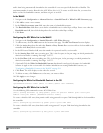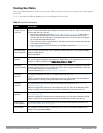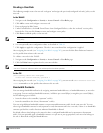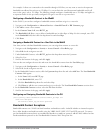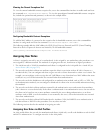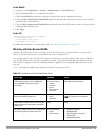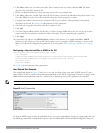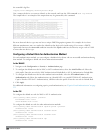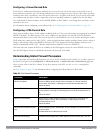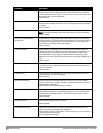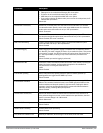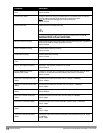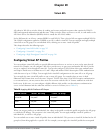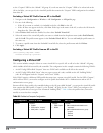
309 | Rolesand Policies DellPowerConnectW-SeriesArubaOS6.2 | User Guide
the controller’s log files:
logging level debugging network process dhcpd
Now, connect the device you want to identify to the network, and issue the CLI command show log network.
The sample below is an example of the output that may be generated by this command.
Be aware that each device type may not have a unique DHCP fingerprint signature. For example, devices from
different manufacturers may use vendor class identifiers that begin with similar strings. If you create a DHCP-
Option rule that uses the starts-with condition instead of the equals condition, the rule may assign a role or VLAN
to more than one device type.
Configuring a Default Role for Authentication Method
For each authentication method, you can configure a default role for clients who are successfully authenticated using
that method. To configure a default role for an authentication method:
In the WebUI
1. Navigate to the Configuration > Security > Authentication page.
2. To configure the default user role for MAC or 802.1x authentication, select the AAA Profiles tab. Select the
AAA profile. Enter the user role for MAC Authentication Default Role or 802.1x Authentication Default Role.
3. To configure the default user role for other authentication methods, select the L2 Authentication or L3
Authentication tab. Select the authentication type (Stateful 802.1x or stateful NTLM for L2 Authentication,
Captive Portal or VPN for L3 Authentication), and then select the profile. Enter the user role for Default Role.
4. Click Apply.
For additional information on configuring captive portal authentication, see "Captive Portal Authentication" on page
233.
In the CLI
To configure the default user role for MAC or 802.1x authentication:
(host)(config) #aaa profile <profile>
mac-default-role <role>
dot1x-default-role <role>
To configure the default user role for other authentication methods:
(host)(config) #aaa authentication captive-portal <profile>
d>efault-role <role>
(host)(config) #aaa authentication stateful-dot1x
d>efault-role <role>
(host)(config) #aaa authentication stateful-ntlm
d>efault-role <role>
(host)(config) #aaa authentication vpn
d>efault-role <role>



